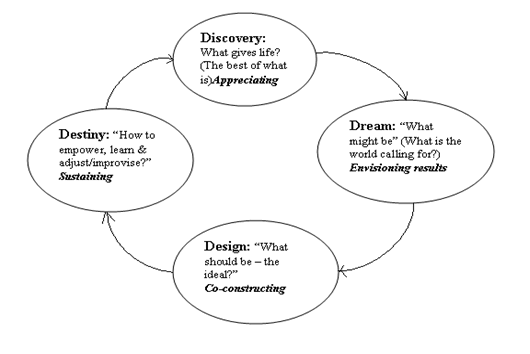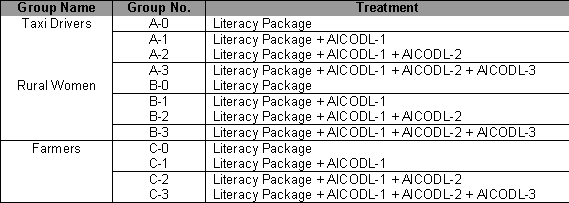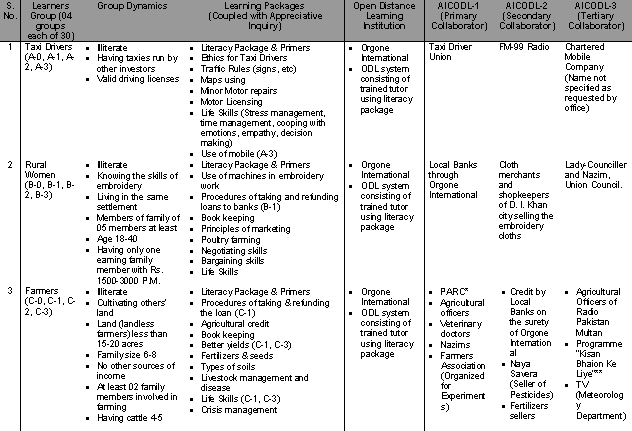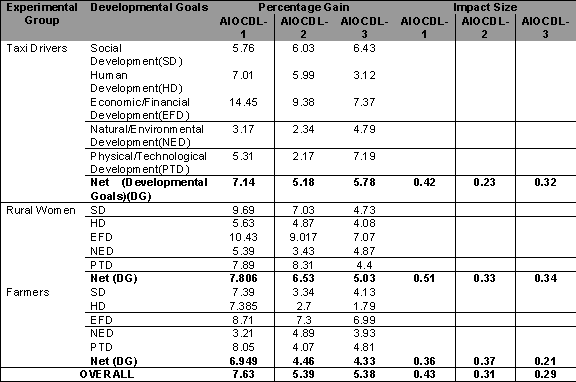|
Vulnerability of Appreciative Inquiry (AI) in Collaborative Open and Distance Learning (AICODL) for Achieving Developmental Goals Muhammad Zafar Iqbal, Secondary Teacher Education Department, Allama Iqbal Open University, Islamabad, Pakistan Abstract
In recent decades the vocational trainers have initiated “Partnership in Development” and “Rights-based Development” and many other partners like, banks, educational institutions, media, NGOs, international organizations, industry and professional organizations. It is a practice that involves the local institutions as partners to mitigate their problems through participated technique. In a more concise form this schemata for achieving developmental goals and attempts to capture broader scenario of the development may be actively utilized for ODL system particularly in the case of women and rural setups. Collaborative learning may be defined as “a situation in which people learn or attempt to learn something together”. [3] The main limitations of open distance learning uptill this day of 21st century are separation of teacher and learner in space and/or time [8], absence of appreciative inquiry; the violation control of learning by student rather than distant instructor and/or institution [6], noncontiguous communication between student and teacher mediated by print media [4], mediating distance teaching with local collaboration through face-to-face interaction [11] and sharing of experiences, information and expertise with one another [13]. ODL cannot deliver properly as separate entity or as an isolated entrepreneur until and unless associated with endeavors of all stakeholders for the developmental goals particularly to embrace the changing scenario of development. Experience of PANdora Project of IDRCC (2005-2006) has given an operative position to ICT-based independent and blended collaborative ODL models for achieving the developmental goals in Asian Countries. [1]. The impact analysis of experiments like that Appreciative Inquiry Woks of Chandi Parshad Chapagain (2004) [9], CCCDA (Child Centered Community Development Approach) and World Bank’s initiative of “sharing knowledge to achieve development goals” [12], and it provides a workable model for AICODL. Figure 1 - Appreciative Inquiry (AI) 4-D Cycle Appreciative Inquiry (AI) may briefly be described co-revolutionary search for the best in people, their organization and the relevant world around them. AI involves the arduous task of intervention to speed-up imagination and innovation instead of negation, criticism and spiraling diagnosis: discovery, dream, design, destiny. AI seeks, fundamentally, to build a constructive union between a whole people and the massive entirety of what people talk about as past and present capacities: achievements, assets, unexplored potentials, innovations, strengths, elevated thoughts, opportunities, benchmarks, high point moments, lived values, traditions, strategic competencies, stories, expressions of wisdom, insights into the deeper corporate spirits or soul, and visions of valued and possible futures [2]. The unique feature of the Appreciative Inquiry approach is its commitment to seeking and drawing upon the root causes of success rather than those contributing to failure. It makes people more inquisitive, and more intensely interested in open distance learning more about how to use their intrinsic and instrumental power. Appreciative Inquiry, a shifts from problem-focus interactions, when properly structured is far more than a public relations, or ‘feel good’ approach and it simply follows the 4-‘D’ cycle, given below. [2] The distance education system like every system is still stick to the problem solving approach commencing with the identification of problems without taking into consideration any alternative options. Problem solving approach cannot capacitate the ODL learners until Appreciative Inquiry is linked with it. Problem oriented approach is closed, deficit and expert fed approach whereas Appreciative Inquiry Open Collaborative Distance Learning (AIOCDL) approach is open, collaborative, visionary and sharing based that can easily transfer the learning package to the individuals to enhance their capacity & consort towards their sustainable 5 dimensional development, e.g., instead of starting from “what does not work” or “what is wrong” or “whose fault is it”, AIOCDL starts from “what works” or “what are the other possibilities” or “what can we do” or “let us collaborate, unite and act towards the development of individuals, organizations, society and systems to achieve the developmental goals”. System with noble human values, attitude, styles, skills, capabilities, etc., to achieve the MDGs through inter-subjectivity mediated development is possible through AICODL approach for the development of individual, organizations, society, country and South Asian region of the globe [10]. AICODL initiative may prove an attempt beneath effective sharing of needs and coordination of efforts of various key players endeavoring for achieving the developmental goals. ASSUMPTION The study postulates that open learning approach is not self-sufficient in itself unless it appreciatively and positively shares the program development and “delivery of goods” with other stakeholders like CBOS, NGOs, employers, trade associations, industry, informal organizations, media, learners association, farmers, etc. in form of consortium in order to achieve the development goals of individuals, society, region and country. Let the stakeholders unite and act for capacity building of outreach semi-skilled and skilled workers who have been, since ages, facing problems of livelihood inherited from their ancestors. The concept assumes that development is essentially about systematic, open and deliberate application of appropriate policies and utilization of resources for raising the material and moral standard and well-being of people for self-discipline and self-emancipation. AICODL may feature consensus building through which learners may develop skills in collaborating with other colleagues and cooperating with divers individual. Such skills are increasingly needed in indigenous workplaces. AICODL is a ragbag of ideas and procedures accompanied by hope for distance and open learning. OBJECTIVE The aim of this research crystallizes from the need to develop an environment of Open Distance Learning associated with Appreciative Inquiry which could be applied outside the arena of ODL institution only but seeking the collaboration of relevant stakeholders particularly those of the learners associations. The objectives followed naturally: To facilitate several forms of the collaboration for developing the open distance learner in vocational training. To provide a deep motivation through Appreciative Inquiry grounded in domain expertise of professional skills which may produce an immersive pedagogical environment for adult learners. To measure the enhancement in the achievement of five types of developmental goals of learners with addition of each collaborator in Open Distance Vocational Training. HYPOTHESIS The study is based on the assumption that human resources having appreciative/positive attitude and behaviour towards personal and societal development through learning are more capable of achieving developmental goals than the once with negative approaches/trades. The study intends to justify that open distance learning coupled with the 4-D cycle of the Appreciative Inquiry is helpful in achieving the enhanced degree of five types of developmental goals, if done in collaboration with the different stakeholders. METHODOLOGY Four groups of each of the three kinds of the sample were targeted each for three months duration. Total experimental cycles for all four parallel groups was of one year duration. The project sought Appreciative Inquiry, Collaboration and Developmental Goals as central pedagogical principle for constructivist paradigms of learning and accepted that any vocational training should start from this base. [5][7]. Collaboration gives learners real life experiences of learning in a group, learning from others and contributing their own understanding about developing their vocational skills & enhancing five categories of developmental goals. The experiment accepted the basic premise that adult learners are encouraged to accept for their contributions to the vocational learning process which should lead to improve personal development. DELIMITATION OF DEVELOPMENTAL GOALS Developmental Goals were limited to the following five dimensions for the purpose of this experiment.
SAMPLE For this purpose 04 groups of three kinds of the clientele vis-à-vis taxi drivers of Rawalpindi & Islamabad, farmers of 04 adjacent villages (Mauzas) of Khanewal district, and rural women of D. I. Khan earning their livelihood through embroidery work. A target of 120 (04 groups each of 30) was taken as sample for each of three kinds. Need assessment & identification of target sample was made with the help of CBOs, NGOs & respective associations (taxi driver unions, farmers associations, and rural women associations), Nazims & councilors. PACKAGE DEVELOPMENT Package was specially developed by the project team Orgone International (an organization working in action research in ODL). It consisted of primers for literacy, three Rs, audio cassettes recorded in locally spoken language, flip charts, handouts, models, charts, pictures, and practical exercises. It contained the lessons on Child Care, Population Education, Sanitation, First Aid, Family, Health, & Environment. TREATMENT Three tutors were trained from three sites of the project for providing literacy using specially developed literacy package. They were specifically trained in Androgogy using Appreciative Inquiry. Tutoring was given for 140 hours in 03 months based on flexibility of timings as suitable to learners in a centrally located place in the area of group for each of four of all categories. First three badges on the three sites (A-0, B-0 & C-0) were made only literate and at the end of 03 months cycle the level of five types of developmental goals was measured on 10-point indicators criteria for each type of the developmental goals. This was treated as base-line achievement. For 2nd, 3rd and 4th cycle of each group one collaborator was added and curriculum was also enhanced accordingly as indicated in Table # 1 and Table # 2. The achievement of developmental goals was measured for each cycle for each group. Table # 1 Showing the Group Wise Treatment Data was analyzed using percentage gain of developmental goals alongwith calculating the impact size of each collaborator for three groups separately alongwith the aggregate. The following is the fundamental formula which was used to find out impact size, in this study; Figure 2 In this formula, M is Mean and S is Standard Deviation. An impact size of 1.0 indicated an increase of one standard deviation. Impact sizes are often expressed as percentiles of percentage improvement to help with interpretation of what particular impact size means. For example, an impact size of 1.0 indicates that 845 of the treatment group performed better than subjects in the baseline group (Groups A-0, B-0, & C-0 in this study) which scored at the mean. Table # 3 indicates that there is 7.63% increase in the overall achievement of developmental goals with the manipulation of primary collaboration (AIOCDL-1) and 5.39% increase in the achievement of developmental goals for every additional collaborator. The increase in economic/financial developmental goals came to be maximum almost in all of the three groups. However, deviations were observed in case of human developmental goals particularly in case of farmers. The achievement for rural women group came to be maximum (7.806% & 6.53%) for primary and secondary collaboration but it was maximum (5.78%) in case of taxi drivers for tertiary collaborator. The impact size for the achievement of developmental goals for primary collaborator is 0.43 while for each additional collaborator is 0.3 approximately. The impact size also remained maximum in case of rural women and minimum in case of farmers for tertiary collaborator, however, it remained minimum (0.23) in case of taxi drivers for secondary collaborator. LIMITATIONS
CONCLUSION The study concludes that impact of collaboration of one additional primary stakeholder (AICODL-1) increases the achievement level of development goals by approximately 7.63 %. The increase for one secondary level collaboration (AICODL-2) is approximately 5.39%. The paper further concludes that ODL can not deliver properly as separate entity or as in isolated entrepreneur until and unless associated with endeavors of all stakeholders for the developmental goals particularly to embrace the changing scenario of development. It summarizes the building collaborative dialogue among main actors, technical architecture of AICODL system and the pedagogical implications of the suit. These relate to the diagnosis of learning needs, developing the learning package, execution, harnessing new technology, updating the learners’ skills, linkage with industry and successful maintenance of collaboration leading to sustainability and appreciative attitude of collaborating organs. RECOMMENDATIONS As a consequence, the study recommends that, AICODL initiative may prove an
attempt to find the hope that lies beneath widespread implication of open learning
and effective sharing of needs and coordination of efforts of various key players
endeavoring for achieving developmental goals. It also emphasizes that AICODL
may be properly tested as an operative model at national/international level.
Hopefully it may prove a building block for achieving the developmental goals.
The study may be extended to larger numbers and more number and types of groups
in the second phase. ODL institutions may replicate study on larger populations
and then make part of their system. The experiment may be conducted on longitudinal
basis such that all the 12 groups may be given all the treatments and measuring
the effect of achievement of developmental goals for each category for each
treatment. REFERENCES
Figures |




